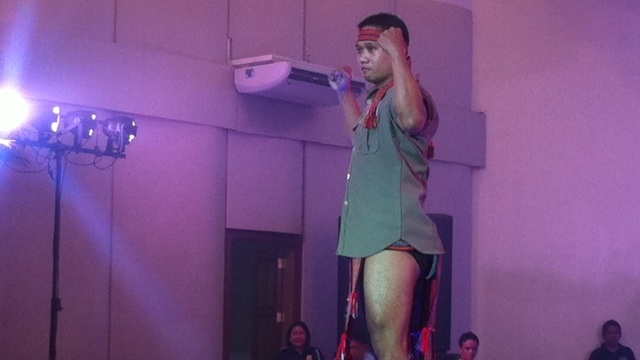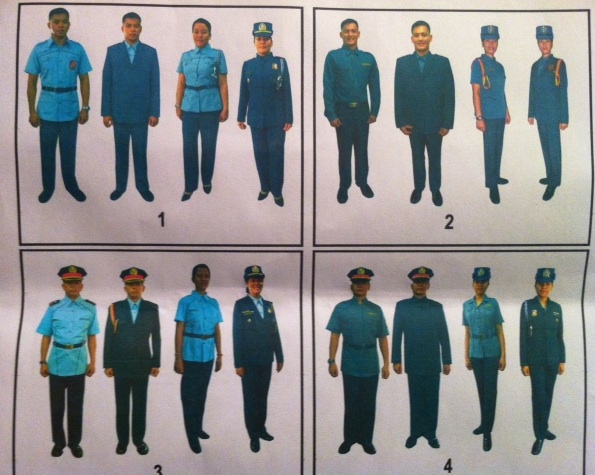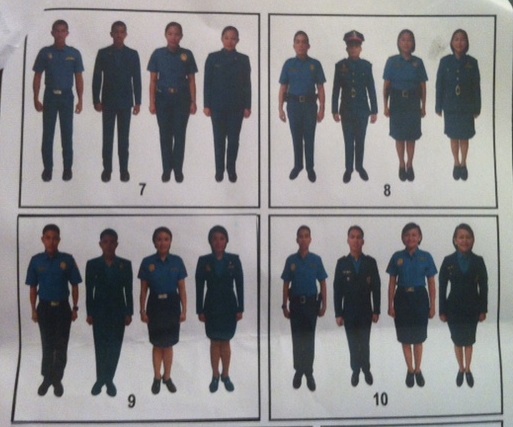SUMMARY
This is AI generated summarization, which may have errors. For context, always refer to the full article.

MANILA, Philippines – Fashion models do the catwalk. Policemen modelling service uniforms? They do the “copwalk.”
This is exactly what officers did on Thursday evening, July 4, when they traded their firearms and fierce looks for accessories and makeup to showcase the various possible designs for new Philippine National Police (PNP) uniforms.
The fashion show – called “Copwalk: PNP on the Ramp” – was staged at Camp Crame in search of the force’s next uniform design.
The Directorate for Research and Development (DRD), under Director Gil Hitosis, said they sought the help of fashion designers for this.
But, he joked, the audience should not expect to see at the event the “tsunami walk” or “cobra walk” – styles made famous by Philippine beauty queens. Rather, they would witness a “tactical and strategic walk,” simply called a “copwalk.”
Policemen and women walked the stage donning proposed uniforms, trading their usual fierce persona with makeup, warm smiles, and fashion swagger.
Every 10 years, the National Police Commission (Napolcom) allows cops to change uniform designs, Hitosis said. The PNP, however, has been using the same uniform for 17 years.
Following complaints from police officers that the current polyester uniform is uncomfortable under the heat, he and the rest of the DRD came up with the proposal to look into new designs, which spurred Copwalk.
An internal survey confirmed: policemen wanted a new uniform to wear.
“Our policemen have complained that the old uniform, the 100 percent polyester, is too hot. If you sweat, it’s itchy, it does not afford them comfort. And when we attend conferences abroad, we see the uniform of other police and we see the texture of their uniform is nice. So we thought, it’s about time we improve our uniform too,” Hitosis said.
Functionality, comfort
Copwalk featured 10 different sets of uniforms, which included designs for male and female cops.
The creations were from some of the Philippines’ famous designers, like Rene Salud and Eddie Baddeo, and other independent designers. These designers suggested types of material and style that would be of the best quality and comfort.
Hitosis said “functionality and comfort” are their priority.
“Because when you’re uncomfortable in your uniform and you start feeling discomfort while working, you will only last 8 hours. But now we do 12 hours per shift. If your uniform can’t give you mobility, you won’t last. You’ll look for shade or take a rest,” he explained.


Those in the audience – police officers, media, designers, and other guests – were asked to vote for their favorite styles via SMS.
PNP chief Alan Purisima, former Tarlac governor and PNP Academy head Margarita “Tingting” Cojuangco, designers Badeo and Salud were among the judges who helped choose the best styles.
Symbolic change in uniforms
Hitosis said now is the perfect time to introduce new uniforms.
Not only does the agency have money – a refreshing change from past years – he said the change symbolizes the reforms instituted in the PNP by the Aquino administration.
Some of these reforms include modernization of equipment, additional benefits, and a more merit-based promotion system. Hitosis said it made sense that the uniforms would be one of the changes as well.
While most designs looked generally similar to the current uniform, the slight changes were reflected in the sleeves, collars, and other details.
Some used gold buttons, others had more patches, while still other modifications showed altered hat styles. Most of the suggested uniforms were made of cotton, which gives the most relief from the sun.
All proposals stuck to the blue color, which Hitosis said is the international color for the police force.
Sindac clarified that nothing is set in stone and changes in the proposed designs are still up for debate. The Uniform and Equipment Standardized Board, taking in all comments and preferences, will make the ultimate decision.
If a new uniform design is finally be approved, this would not entail any additional expenses. Every police officer is mandated to receive a P14,000 Replacement Clothing Allowance (RCA) every 3 years.
Aside from comfort and functionality, Hitosis explained the importance of the uniform to the police force, emphasizing it “symbolizes authority and commands respect.”
“Even if our work is good, if [the uniform is] lousy or it’s ordinary, when we make arrests they won’t mind us,” Sindac said. “But when we’re wearing our uniform, immediately people know, I am a police.” – Rappler.com
Add a comment
How does this make you feel?
There are no comments yet. Add your comment to start the conversation.